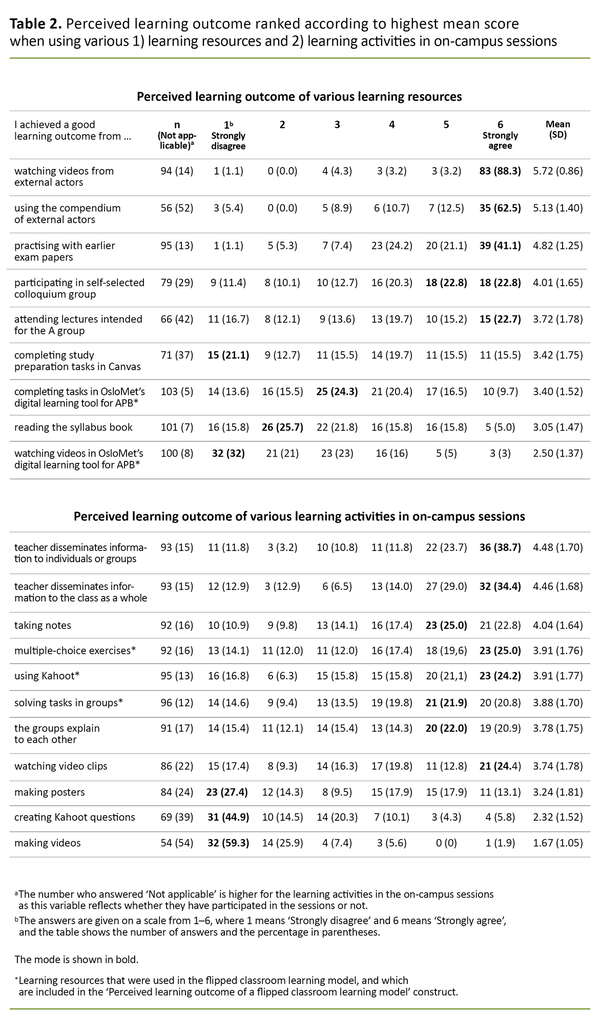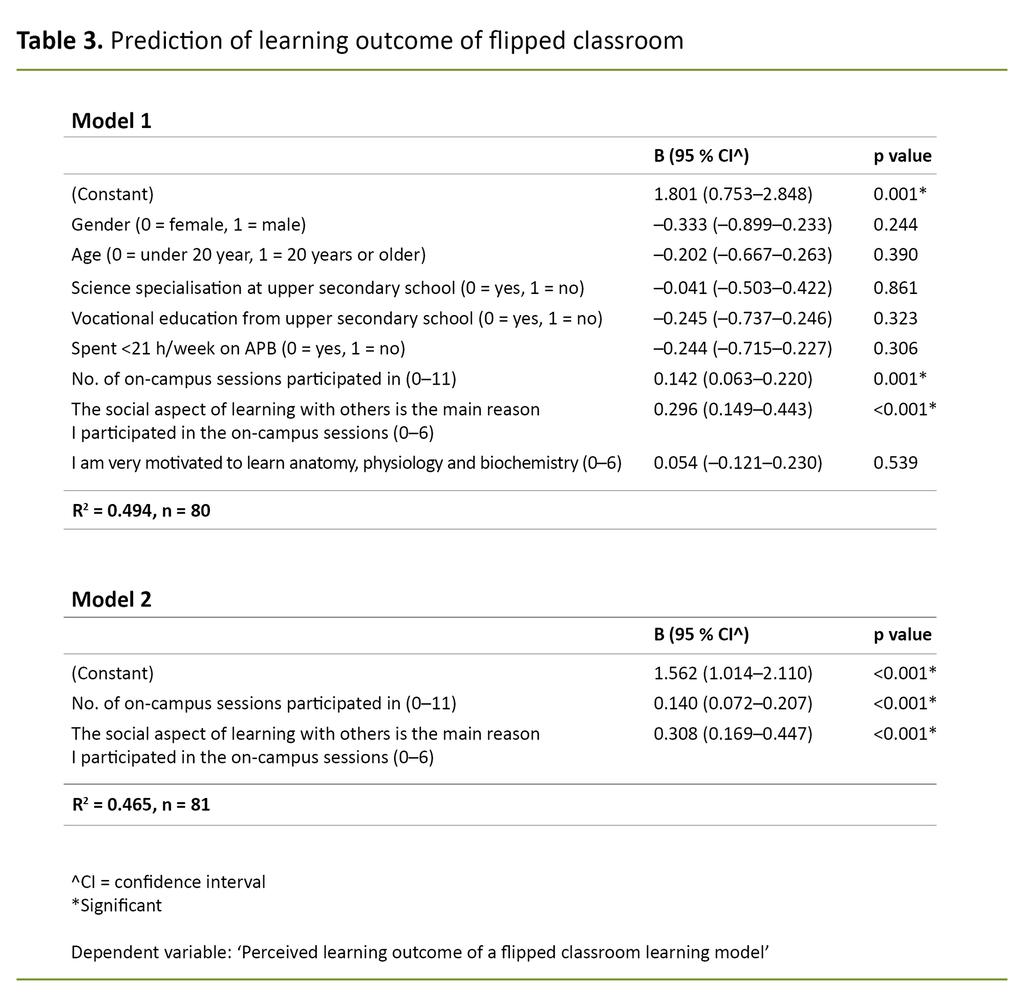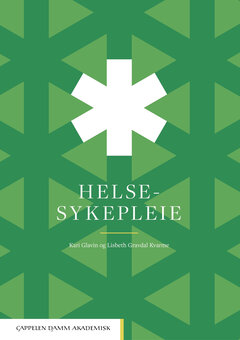Anatomy, physiology and biochemistry: nursing students’ perceptions of the learning outcome from a flipped classroom
The learning outcome improved when digital resources were combined with teacher-led activities in lectures. Working in a social setting and participating in group work also had a positive effect on students’ learning.
Background: Anatomy, physiology and biochemistry (APB) is a course that nursing students find challenging. The flipped classroom approach, where instruction is based on a student-centred model as opposed to traditional lectures, has previously led to good learning outcomes for this course in the radiography study programme at Oslo Metropolitan University (OsloMet). A similar flipped classroom teaching model was therefore trialled in the nursing study programme at OsloMet, Pilestredet Campus, in autumn 2018.
Objective: The objective of this study was to examine nursing students’ perceptions of the learning outcome from various learning resources and activities, with a focus on the students who were part of a flipped classroom learning model, known as PISA. We also wanted to investigate whether attendance at on-campus sessions and various background factors impacted on the overall perceived learning outcome from a flipped classroom.
Method: We examined the students’ (n = 232) perceptions of the learning outcome from different learning resources and activities in APB using a quantitative questionnaire, which also included some background questions. We used multiple regression analysis to identify which variables affected the overall perceived learning outcome from a flipped classroom learning model.
Results: The students believed that some of the best learning outcomes stemmed from learning activities and resources that entailed the lecturer’s presence and social interaction between the students. In relation to the activities and resources in the flipped classroom model, the students considered OsloMet’s internal digital resources to give the poorest learning outcome. The overall learning outcome of the flipped classroom learning model was shown to have a significant association with the number of on-campus lessons that students participated in, as well as the students’ emphasis on the social aspect of learning with others.
Conclusion: Attendance at on-campus sessions seems to be a success factor for the perceived learning outcome from the flipped classroom learning model. Furthermore, students considered teacher-led instructions and lectures to have a major positive effect on their learning outcome. This was also the case for student-centred activities.
Traditionally, teaching at higher education institutions has taken the form of study material being presented in lectures (1). However, students are not passive recipients of knowledge from lecturers who serve as disseminators of information – learning is a subjective process that arises in the interface between the student and lecturer (2).
According to summarised research findings, this approach to learning requires students to work actively with the study material and reflect on their own learning, thereby stimulating a deeper understanding of the subject and in-depth learning (3).
A growing focus on student activity and technological advances have led to a greater emphasis on more dynamic learning models in recent years (1, 4).
According to summarised research findings from quantitative and qualitative studies, various forms of e-learning can promote flexibility as well as foster metacognition in students’ learning (5).
Definition of the ‘flipped classroom’
The flipped classroom is a form of e-learning (6, 7) that entails students being introduced to study material prior to on-campus lessons, e.g. videos of lectures, via the chosen learning platform, YouTube or another digital learning tool.
In this approach, the emphasis in the on-campus lessons is on various forms of student-centred activities as opposed to traditional lectures. Some studies show positive experiences with this method (6–8), but summarised research findings also indicate that learning initiatives on a smaller scale should be investigated before broad implementation of the flipped classroom (5).
The majority of registered nurses in Norway are educated at Oslo Metropolitan University (OsloMet), whose vision is to offer the best nursing study programme in Norway (9). In addition, OsloMet’s overarching strategy and vision place a strong emphasis on facilitating the use of new student-centred learning methods.
Perceived learning outcome versus intended learning outcome
A recent study shows poor exam results in science subjects among nursing students, and points out that this may be partly due to the fact that the science course is taken in the first semester when many are still new to the student role (10). The course is also considered to be disconnected from and poorly integrated with clinical reality, and requires a large syllabus to be covered in a short period of time (11).
Learning outcomes are the knowledge, skills and general competence that students can expect to have acquired upon completion of their studies (12). It is common practice for students to undergo a summative assessment – in the form of a test or exam – to establish the extent to which they have achieved the intended learning outcomes.
However, students’ subjective perceptions of their learning outcomes are not necessarily the same as the intended learning outcomes. Knowledge about the students’ perceptions of their learning outcomes is useful for gaining insight into their learning. It can also help guide the further development of the course and therefore constitutes a type of formative assessment (13).
As far as we are aware, no studies have been conducted that examine students’ perceptions of the learning outcomes from the learning approach applied in our study.
Objective of the study
Replacing traditional lectures with a flipped classroom has previously led to a good learning outcome in APB on the radiography study programme at OsloMet (14), and we therefore wanted to investigate whether it may also be beneficial to adopt this pedagogical approach in APB in the nursing study programme.
The objective of our study was to investigate the nursing students’ perceptions of the learning outcome from the flipped classroom in APB. The research questions we wanted to investigate were as follows:
- What are the nursing students’ perceptions of the learning outcome when using different learning resources in a flipped classroom model?
- What are the nursing students’ perceptions of the learning outcome from various on-campus learning activities?
- What factors impact on nursing students’ perceptions of the learning outcome when using a flipped classroom learning model, known as PISA?
Method
Study participants
In the autumn of 2018, a flipped classroom learning model was trialled in the APB course in the Bachelor’s degree in nursing at OsloMet, Pilestredet Campus.
The student cohort was divided into two groups. One of these groups (n = 232) was further divided into four smaller groups of 50 to 70 students, who were given the opportunity to attend weekly on-campus sessions. The remainder of the cohort (n = 280) had traditional lectures and were not included in this study.
Flipped classroom learning model and learning resources used
Moocahuset at OsloMet has developed a flipped classroom learning model called the PISA model (15). The ‘P’ stands for presentation, which can be short videos, text, audio files etc., and is intended to replace traditional lectures.
The ‘I’ stands for interaction, which can be digital quizzes, learning paths etc. The ‘S’ stands for the Norwegian word for cooperation, which involves various organised learning activities carried out by the students, preferably in groups, and the ‘A’ stands for analysis, such as reflection, assessment and analysis of data, and is aimed at further developing the learning (15).
The model is based on a socio-cultural approach to learning inspired by pedagogical theories posited by the psychologist Vygotsky, who believed that social interaction plays a fundamental role in all learning (16). Instead of solely spending lesson time on traditional lectures, the aim – according to the principles of this model – is to spend lesson time on student-centred activities, with a view to improving the learning outcome.
OsloMet has developed its own digital learning tool for use in the APB course, and this was used as a learning resource for presentation (text, videos of lectures) and interaction (quizzes). The students were to prepare for their lesson by reviewing the week’s theme in the digital tool and studying the relevant reading material in the syllabus. Each week, students had the opportunity to participate in a four-hour on-campus, non-compulsory group session led by the lecturer.
In the sessions, the students worked in small groups (n = 11) on various student-centred tasks and activities (cooperation), focussing on the most relevant parts of the syllabus for that week. Multiple-choice exercises and/or activities on a game-based learning platform (Kahoot!) were fixed features of the sessions.
Questionnaire
The data source in the survey is a digital, quantitative questionnaire consisting of both closed and open-ended response alternatives. We created and distributed the questionnaire using Nettskjema, the University of Oslo’s secure and quality-assured solution designed to prevent responses being traced to respondents (https://nettskjema.uio.no/).
The questionnaire was intended to examine 1) the students’ perceptions of the learning outcome from using different learning resources, and 2) the students’ perceptions of the learning outcome from various learning activities that were used in on-campus sessions.
The respondents were asked to respond to statements about their perceptions of learning outcomes using a graded scale from 1 to 6, where 1 = Strongly disagree and 6 = Strongly agree.
The questionnaire also contained some background questions: the number of sessions that students participated in (0–11), gender, age (under 20 years/20 years or older), specialisation in the sciences at upper secondary school (yes/no), vocational education from upper secondary school (yes/no) and the number of hours spent on APB per week (less than 21 hours/21 hours or more).
The questions were developed by three lecturers involved in the project, who are also co-authors in this study. Face validity was ensured by all authors reading the questions thoroughly and deeming them to be relevant.
The students answered the questionnaire anonymously upon completion of the APB course (weeks 46–47), approximately three weeks before the exam. This article only includes results from the closed questions.
Data analysis
We used IBM SPSS Statistics version 22 to analyse the data, and descriptive statistics were used in the analysis of the first two research questions. The dependent variables were measured at the ordinal level (score between 1 and 6), but were also analysed as continuous since this method was considered theoretically meaningful (17).
We therefore calculated descriptive results, such as frequency and percentage distribution, as well as an overall mean score with the associated standard deviation for the various response alternatives.
In the third research question, our analytical approach entailed factor analysis and subsequent linear regression.
We wanted to investigate whether any of the background variables, or motivation or the social aspect of the sessions could predict the perceived learning outcome of the five learning resources or the main components of the flipped classroom learning model (the PISA model).
We therefore created a construct called the ‘Perceived learning outcome of a flipped classroom learning model’, where we calculated the combined score of all the learning activities included in the model.
This model consisted of the following five (indicator) variables, in which students scored the perceived learning outcome of the following learning resources and activities:
- videos from OsloMet’s digital learning tool for APB (presentation),
- tasks from OsloMet’s digital learning tool for APB (interaction),
- tasks set during on-campus sessions (cooperation),
- Kahoot! used in on-campus sessions (interaction), and
- multiple-choice exercises (cooperation) used in on-campus sessions.
Before calculating the aggregate variable, we used principal component analysis to investigate whether the five indicator variables were included in one factor (factor loadings 0.596–0.843), and this was subsequently confirmed (Kaiser-Meyer-Olkin test, KMO = 0.671, Bartlett’s test = p < 0.001).
The reliability of the construct ‘Perceived learning outcome of a flipped classroom learning model’ measured using Cronbach’s alpha was 0.80.
To investigate whether any of the background variables showed an association with the construct, we performed a multiple linear regression analysis, with a significance level of 5 per cent.
Ethical considerations
The study does not include information about the health of respondents or others, and it was therefore not necessary to apply to the Regional Committees for Medical and Health Research Ethics (REC). It was also deemed unnecessary to inform the Norwegian Centre for Research Data (NSD) as the study did not involve collecting personally identifiable information.
Participation in the survey was anonymous and voluntary. Information was provided at the start of the questionnaire about the purpose of the study and what the student’s participation entailed, and it was stated that all data collected would remain anonymous.
The students gave their consent to participate by responding to the survey, and the study was conducted in accordance with research ethics guidelines set out in the Declaration of Helsinki and the Vancouver rules.
Results
Study sample
The student cohort being taught using the flipped classroom learning model was invited to participate in the study. A total of 108 of 232 students (46.6 per cent) chose to answer the questionnaire (Table 1).
Perceived learning outcome of various learning resources
The students were asked about their perceived learning outcome from using different learning resources (Table 2).
The videos in the presentation learning resource from OsloMet’s digital learning tool for the flipped classroom model had little effect on the learning outcome, and this was also the case for the interaction learning resource tasks in the tool (Table 2).
In contrast, the students indicated that resources from an external actor and earlier exam papers had a very positive effect on the learning outcome. The on-campus lectures were aimed at the group of nursing students who were not included in our study.
The students indicated that resources from an external actor had a very positive effect on the learning outcome.
It was therefore surprising that 66 students in the study (42 per cent) stated that they had attended these lectures. Of these, 22.7 per cent indicated that they ‘Strongly agreed’ that the lectures contributed to a good learning outcome.
Perceived learning outcome from various learning activities used in the on-campus sessions
The students reported a mean score of between 3.88 and 3.91 for the learning outcome of all activities that were fixed features of the learning model (Table 2).
It is interesting to note that the highest scoring learning outcomes for activities in the on-campus sessions related to the lecturer as the disseminator of information, either to the classroom as a whole or to individuals or groups.
At the other end of the scale are the activities that the students consider to have given a poorer learning outcome, such as activities that involved the students themselves having to create something, such as posters, videos or Kahoot! questions.
Variables that predict the perceived learning outcome of the flipped classroom model
The ‘Perceived learning outcome of a flipped classroom learning model’ construct achieved a mean score of 3.59 (standard deviation [SD] 1.20). The multiple regression model explained 49.4 per cent of the variation (Model 1, Table 3).
The variables that had a significant effect on the construct were the number of on-campus sessions that the student had participated in, as well as the statement ‘The social aspect of learning with others is the main reason I participated in the on-campus sessions’.
Neither gender, age, specialisation in the sciences at upper secondary school, vocational education from upper secondary school, number of hours spent on APB or motivation had a significant effect on the construct.
In model 2, the variables that affected the construct significantly were included by performing stepwise regression, and these two variables alone explained 46.5 per cent of the variation (Model 2, Table 3).
Discussion
The flipped classroom learning model has previously been shown to have a positive effect on radiography students’ grades in APB at OsloMet (14). Nevertheless, according to figures from the Norwegian Agency for Quality Assurance in Education (NOKUT), the exam results for APB in the nursing study programme at Pilestredet Campus were not significantly better overall in the exam in autumn 2018 than in previous years (18).
However, it is not possible to see from these figures whether using the flipped classroom approach had any positive effect. Exam grades represent a summative final assessment as a measure of intended learning outcomes, which does not necessarily reflect students’ perceptions of their learning outcomes.
The results indicate that the perceived learning outcome of the elements included in the learning model was somewhat low, and that attendance at on-campus sessions seemed to be an important component in the total perceived learning outcome of the flipped classroom learning model.
Thorough training in the learning model is needed
The results showed that the perceived learning outcome of OsloMet’s internal digital resources for presentation was poor compared to similar resources from an external commercial actor.
A recent study of nursing students’ experiences with the flipped classroom in APB at another educational institution also found that many of the students chose to use external digital resources instead of internal ones (19).
The students tend to ‘shop around’, and they appear to choose the learning resources they themselves consider appropriate.
Earlier reports on quality in higher education have shown that the use of digital tools is in many ways an integral part of students’ lives, but that the digital resources used on the course are not necessarily the same as those that the students choose to use (20, 21).
The students tend to ‘shop around’, and they appear to choose the learning resources they themselves consider appropriate. A Ministry of Education and Research report from 2018 giving an evaluation of higher education asserts that digital learning resources do not necessarily promote learning in itself, but that these must be incorporated into a well-developed and comprehensive teaching plan (4).
A recent report on how to achieve quality in higher education supports this claim, and highlights the importance of establishing a shared understanding of goals and clarification of expectations in relation to the relevant learning activities and resources (20).
It is reasonable to assume that such clarifications are particularly important where students have little previous experience with the learning model. It cannot be ruled out that the perceived learning outcome may have been better if the students had undergone more thorough training and the expectations were clearer.
High scores for activities where the lecturer was present
On-campus learning activities where the lecturer was present and provided instruction scored high in terms of students’ perceptions of the learning outcome. Another important finding was the high scores for lectures, which were not intended to be part of the learning model.
More than half (57.6 per cent) of the students who attended these lectures agreed (4, 5 or 6 on the scale) that the lectures had a positive impact on their learning outcome.
Similar to this finding, a study of nursing students’ experiences with the use of a flipped classroom in their APB course found that increasing the number of on-campus lectures could have improved learning (19), despite these students also having the opportunity to participate in online meetings with their lecturer.
Activities where the lecturer was present and provided instruction scored high in terms of students’ perceptions of the learning outcome.
Our results concur with a survey of students’ perceptions of the learning outcome in a course at the Police University College, which combined on-campus and remote learning activities. Here, campus-based lectures were considered to have the greatest impact on the perceived learning outcome (22).
Students’ often consider ‘good learning’ to be the result of a good lecturer or supervisor who is able to motivate and inspire them, as well as the use of suitable student-centred learning methods (13).
Meta-analyses have shown that teachers play a major role in learning, known as the ‘teacher effect’ (23, 24). A new qualitative study of students’ experiences with the flipped classroom found that this learning model made students feel that both the lecturer and their fellow students ‘saw’ them, and that it boosted motivation and reinforced their commitment to attend lessons (25).
Activities that stimulate various forms of student-centred learning have previously been reported to increase student engagement in APB (26).
Nevertheless, many nursing students prefer passive rather than interactive lectures, possibly due to low self-confidence in the subject (27). Teaching in small groups may therefore be an effective strategy.
Compulsory attendance improved learning outcomes
Attendance at on-campus sessions was not compulsory. A previous study showed high scores for students’ perceptions of the learning outcome from compulsory activities, but that students failed to take part in voluntary activities (22).
Previous research into on-campus learning has shown that attending lessons is positively associated with increased learning (28). However, few studies have examined this in a flipped classroom scenario.
A recent Norwegian study is probably the first to examine how attending on-campus sessions using the flipped classroom approach impacted on learning in an introductory course for first-year mathematics students (29). The study used a flipped classroom learning model similar to that in our study, and found that attendance at on-campus learning activities was a strong predictor of students’ scores in a test held on the last day of lessons.
Although this test was a summative assessment, these results are consistent with our finding that participation in the on-campus sessions is a significant predictor of the overall learning outcome of the flipped classroom learning model.
Students’ efforts were significant for the learning outcome
According to NOKUT, the quality of education cannot be assessed solely on the basis of the end result (subject grades) and the efforts of the learning institution; it will also depend on the students’ abilities, motivation and effort (13). When considering our findings in light of this, however, it was only the students’ efforts, measured by the number of sessions they had participated in, that were a significant predictor of the learning outcome in the flipped classroom.
Motivation, or whether the student had specialised in the sciences at upper secondary school, or had a vocational education, showed no significant association with the students’ perceptions of the learning outcome from the learning model.
A recent literature review shows that nursing students’ prior knowledge may be positively associated with a good end result in APB (11), but that age at admission, self-confidence in the subject and study technique may have impacted on the result.
However, nursing students and registered nurses across cohorts and national borders agree that the time set aside in the study programme to learn the subject is insufficient (11).
It is possible that emphasising continuous effort can be a key factor in students achieving and feeling that they have achieved a good learning outcome. As previously reported, nursing students want tools that can ensure effective learning and progress in the subject (19).
The social aspect of learning with others is important
The social aspect of learning with others seems to have a large impact on the perceptions of learning outcomes. This finding is in keeping with a sociocultural perspective on learning and Vygotsky’s theory of students’ proximal developmental zone, which posits that knowledge is best constructed through interaction with other students and in a relevant context (16, 30).
Creating a safe framework and good relations between students contributes to learning (23) and is also in line with the theory that students can serve as scaffolding for each other (31), which is supported by the findings in a recent qualitative study (25).
The social aspect of learning with others seems to have a large impact on the perceptions of learning outcomes.
Some students may find the flipped classroom a lonely experience, with a lot of time spent on self-study off campus (19). Research also suggests that physical presence and face-to-face communication are important for establishing a social context for learning (19, 20).
Consequently, this factor is assumed to be closely linked to attending lessons. Our findings are in keeping with the findings of a qualitative study of students’ experiences, which indicates that the flipped classroom approach reinforces students’ commitment to participate and makes it more difficult to drop out (25).
When considering the overall importance of attending lessons and the social component, the findings may suggest that more emphasis should be placed on these factors in curriculum design and lesson planning.
The fact that the flipped classroom learning model resulted in more satisfied students may be related to the high participation rate in on-campus, teacher-led sessions. This may, in essence, be more about the ‘teacher effect’ and/or the students’ interaction and less about them actually attending lessons.
Methodology considerations
The study had a high response rate, which adds validity to the findings. The survey helps to shed light on students’ perceptions of the learning outcome from the flipped classroom, but the results are not necessarily transferable to other samples. The results of the open-ended questions will be published in separate articles.
Conclusion
The results suggest that students’ perceptions of the learning outcome from the flipped classroom in APB have a direct correlation to the number of on-campus sessions they participated in. In addition, the perceived learning outcome was more positive among students who emphasised the social aspect of learning with others.
Our findings also show that teacher-led activities, both in the on-campus sessions and at lectures, were among the learning activities that the students felt led to a good learning outcome, followed by student-centred activities.
Overall, the results suggest that students’ perceptions of the learning outcome can be improved through a learning design for a flipped classroom approach, where digital resources are combined with (compulsory) on-campus sessions consisting of lectures or teacher-led activities with follow-up group work.
References
1. Meld. St. 16 (2016–2017). Kultur for kvalitet i høyere utdanning. Oslo: Kunnskapsdepartementet; 2017.
2. Sawyer RK. The Cambridge handbook of the learning sciences. 2nd ed. Cambridge: Cambridge University Press; 2014.
3. Prince M. Does active learning work? A review of the research. Journal of Engineering Education. 2004;93(3):223–31.
4. Kunnskapsdepartementet. Tilstandsrapport for høyere utdanning 2018. Oslo: Kunnskapsdepartementet; 2018. Available at: https://www.regjeringen.no/contentassets/eb4e02ae65134e42bba060e879536675/oppdatert-publiseringversjon-tilstandsrapport-2018.pdf (downloaded 13.10.2020).
5. McGarry BJ, Theobald K, Lewis PA, Coyer F. Flexible learning design in curriculum delivery promotes student engagement and develops metacognitive learners: an integrated review. Nurse Education Today. 2015;35(9):966–73.
6. Foldnes N. The flipped classroom and cooperative learning: evidence from a randomised experiment. Active Learning in Higher Education. 2016;17(1):39–49.
7. Nouri J. The flipped classroom: for active, effective and increased learning – especially for low achievers. International Journal of Educational Technology in Higher Education. 2016;13(33).
8. Røe YØ, Ødegaard NB, Dahl-Michelsen T. Flipping the classroom in physiotheraphy education: experiences, opportunities and challenges. Nordic Journal of Digital Literacy. 2018;13(4):24–37.
9. Høgskolen i Oslo og Akershus (HiOA). Strategi 2024 – Ny viten ny praksis. Oslo: HiOA; 2017.
10. Jensen KT, Knutstad U, Fawcett TN. The challenge of the biosciences in nurse education: a literature review. Journal of Clinical Nursing. 2018;27(9–10):1793–802.
11. McVicar A, Andrew S, Kemble R. The ‘bioscience problem’ for nursing students: an integrative review of published evaluations of Year 1 bioscience, and proposed directions for curriculum development. Nurse Education Today. 2015;35(3):500–9.
12. Nokut. Omgrep og termar i NKR 2019. Available at: https://www.nokut.no/siteassets/nkr/begreper-og-termer-i-nkr--tabell-2.pdf (downloaded 18.03.2019).
13. Nokut. Kvalitetsområder for studieprogram 2016. Available at: https://www.nokut.no/siteassets/akkreditering-hu/kvalitetsomrader_for_studieprogram_300816.pdf (downloaded 18.03.2019).
14. Vikestad KG. Fra D til B i snittkarakter på hele kullet i anatomi/fysiologi – PISA-modellen i praksis. Læring om læring. Proceedings fra Læringsfestivalen. 2018;2(1).
15. Høivik H. P-I-S-A. Moocahuset.no. 2019. Available at: http://moocahuset.no/?page_id=3120 (downloaded 21.06.2019).
16. Vygotskij L. Tenkning og tale. Oslo: Gyldendal Akademisk; 2001.
17. Ringdal K. Enhet og mangfold. 4th ed. Bergen: Fagbokforlaget; 2018.
18. Dolonen KA. Sensuren har falt i anatomi, fysiologi og biokjemi: Her er resultatene. Sykepleien.no. 2019. Available at: https://sykepleien.no/2019/01/sensuren-har-falt-i-anatomi-fysiologi-og-biokjemi-her-er-resultatene (downloaded 23.05.2019).
19. Bingen HM, Steindal SA, Krumsvik R, Tveit B. Nursing students studying physiology within a flipped classroom, self-regulation and off-campus activities. Nurse Education in Practice. 2019(35):55–62.
20. Nerland M, Prøitz TS. Pathways to quality in higher education: case studies of educational practices in eight courses. Oslo: NIFU (Nordisk institutt for studier av innovasjon, forskning og utdanning); 2018.
21. Henderson M, Selwyn N, Aston R. What works and why? Students perceptions of ‘useful’ digital technology in university teaching and learning. Studies in Higher Education. 2017;42(8):1567–79.
22. Holm R. Hvordan opplever studentene læringsutbyttet på Lederkandidatstudiet ved Politihøgskolen? Norsk Pedagogisk Tidsskrift. 2017;101(2):131–43.
23. Hattie J. Visible learning: a synthesis of 800 meta-analyses relating to achievement. London: Routledge; 2009.
24. Hattie J. Visible learning for teachers. Maximizing impact on learning. Oxfordshire: Routledge, Taylor & Francis; 2012.
25. Steen-Utheim AT, Foldnes N. A qualitative investigation of student engagement in a flipped classroom. Teaching in Higher Education. 2018;23(3):307–24.
26. Johnston ANB, Hamill J, Barton MJ, Baldwin S, Percival J, Williams-Pritchard G, et al. Student learning styles in anatomy and physiology courses: meeting the needs of nursing students. Nurse Education in Practice. 2015;15(6):415–20.
27. Al-Modhefer A-K, Roe S. Nursing students' attitudes to biomedical science lectures. Nursing Standard. 2009;24(14):42–8.
28. Credé M, Roch SG, Kieszczynka UM. Class attendance in college: a meta-analytic review of the relationship of class attendance with grades and student characteristics. Review of Educational Research. 2010;80(2):272–95.
29. Foldnes N. The impact of class attendance on student learning in a flipped classroom. Nordic Journal of Digital Literacy. 2017;12(1-2):8–18.
30. Dysthe O. Dialog, samspel og læring: Abstract forlag; 2001.
31. Bruner J. Utdanningskultur og læring. Oslo: Ad Notam Gyldendal; 1997.













Comments